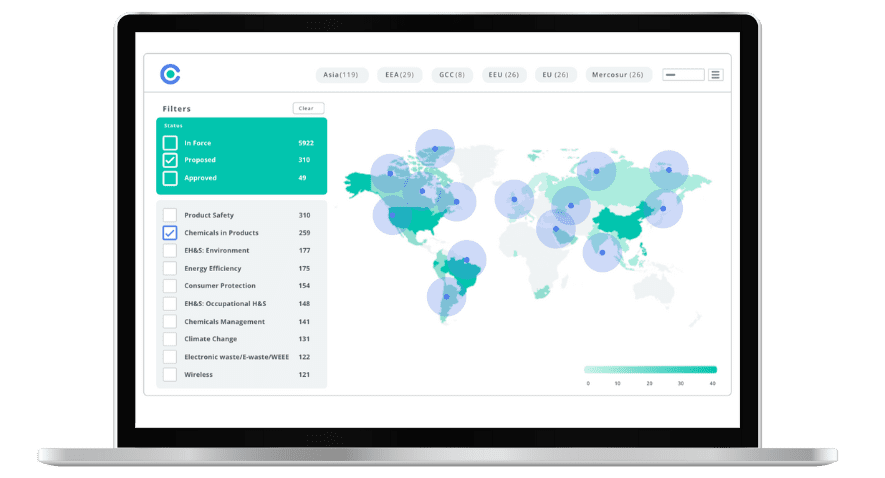
China RoHS Overhaul: Mandatory Standard GB 26572-2025, Expanding Catalogue and Approaching Critical Deadlines

This blog was originally posted on 17th November, 2025. Further regulatory developments may have occurred after publication. To keep up-to-date with the latest compliance news, sign up to our newsletter.
AUTHORED BY JOYCE COSTELLO, SENIOR REGULATORY COMPLIANCE SPECIALIST, COMPLIANCE & RISKS
The regulatory landscape in China for Electrical and Electronic Products (EEPs) is undergoing its most significant evolution since 2016. While China RoHS has been in force for some time, recent actions by the Chinese Ministry of Industry and Information Technology (MIIT) indicate a push towards strengthened enforcement, and a far broader impact, with the proposed expanded scope.
The recent evolution of China RoHS might be seen as comprising 3 key phases, commencing just last year.
Want a high-level snapshot of RoHS rules impacting EEE today? Download our Global RoHS Comparison Table.
Phase 1: Hazardous Substance and Labelling Standards GB/T 26572-2011 & SJ/T 11364 Get An Upgrade (2024-2026)
The original China RoHS framework, established in 2016, mandated restrictions on hazardous substances for a specified list of EEPs only (the “first batch”, issued in 2018 and comprising 12 products). All other EEPs had to document substance use and apply a safe usage period (EFUP/EPUP) label.
From 2018 until last year, China RoHS remained unchanged. Hazardous substances were restricted in 12 products only, and all other products meeting the EEP definition needed to show compliance with SJ/T 11364-2014.
A regulatory overhaul was however initiated in 2024:
GB/T 26572-2011 (the ‘substance standard’) is amended
On 3 July 2024, the ‘substance standard,’ GB/T 26572-2011, was amended for the first time. Amendment No. 1 added four phthalates to the existing ten restricted substances, requiring their limitation in EEPs.
Manufacturers and importers must prepare for the new obligations during the current 18-month transitional period, which runs until 1 January 2026.
SJ/T 11364-2014 (the ‘labelling standard’) is upgraded
The labelling standard, SJ/T 11364, was also upgraded in 2024 to SJ/T 11364-2024.
Action required now
Enterprises are urged to fully implement the revised substance and labelling standards by 1 January 2026.
Phase 2: Building Mandatory Standard GB 26572-2025 (2025-2028)
In a move to strengthen RoHS enforcement in China, MIIT is combining the substance and labelling standards into a single, mandatory standard.
GB 26572-2025 is published
GB 26572-2025 was published on 1 August 2025. Once operational, this new mandatory standard will repeal the current substance and labelling standards (GB 26572-2011, including Amendment No. 1, and SJ/T 11364-2024).
The implementation of GB 26572-2025 follows a “2+1” plan, meaning three critical dates:
| Date | Event | Requirement |
| 1 August 2025 | Publication of GB 26572-2025 | Start of two-year transition period |
| 1 August 2027 | Implementation Date | All newly produced or imported EEPs must comply with GB 26572-2025 |
| 1 August 2028 | Inventory Disposal Deadline | Any products produced or imported before 1 August 2027 must comply with GB 26572-2025 from this date (i.e. a one-year period for selling off inventory complying with previous standards) |
GB 26572-2025 labelling
MIIT has advised that the EFUP mark is usually affixed directly on the visible part of the product. If it cannot be marked on the product due to limitations of product size, shape, surface material or function, it may be moved to the product description.
The information table should appear in the product description.
The carrier form of the product description can be any one of the following: paper instructions, electronic instructions, optical disk (CD/DVD), packaging, system built-in software, and company website.
Phase 3: China RoHS Catalogue Expansion (Proposed 2025)
Following the publication of GB 26572-2025, MIIT has now proposed a 2025 catalogue and exemption list. As was the case with the first batch, the revised catalogue lists the products that must restrict hazardous substances under China RoHS.
The proposed 2025 catalogue would dramatically expand the scope by adding a wide range of new products, including:
- Home/Kitchen Appliances: air purifiers, water dispensers, dishwashers, electric ovens, microwave ovens, electric rice cookers, vacuum cleaners, robot vacuum cleaners, domestic gas instantaneous water heaters
- IT/Networking Equipment: servers, networking exchange equipment, projectors printing/copying/scanning/faxing/multifunction all-in-one machines (consolidated)
- Wearable/Personal Electronics: smart watches/bands, headphones, portable mobile power supplies, smart speakers, electronic smart locks
- Medical/Health Products: electronic blood pressure monitors, blood glucose meters, hearing aids
- Other: industrial washing machines, reading and writing desk lamps, electric toys.
Critical deadline for new catalogue products
The newly-added products must comply with both restriction and labelling obligations from 1 August 2027. This aligns their mandatory compliance date with the implementation of the new mandatory standard, GB 26572-2025.
To clarify, for newly-added products, manufacturers and importers should refer to GB 26572-2025 as the applicable standard.
RoHS exemptions list update
In parallel, the Ministry has also proposed replacing the current exemption list with a newly-revised exemptions list. This would be implemented immediately upon release for products in the first batch. However, if any existing exemption is removed, those companies will avail of a transition period until 1 August 2027 to adjust their operations.
Although not identical to the EU’s exemptions list, the proposed revision does align much more closely with it in contrast to the current list.
Notice No. 23, 2019, which describes the China RoHS conformity assessment system, remains in force as the measure governing conformity assessments conducted under China RoHS 2.
For a comprehensive overview of the RoHS exemptions landscape, recent developments, challenges, and future trends in the EU, check out our Guide RoHS Exemption Roadmap – Navigating Exemption Renewals and Their Timelines.
Conformity assessment
Conformity assessment is mandatory only for electrical and electronic products listed in the Catalogue, and which are manufactured or imported after 1 November 2019.
Companies may choose either of the following methods to complete the conformity assessment:
- Voluntary Certification for Restricted Use of Hazardous Substance in Electrical and Electronic Products companies may choose a third party certification institution to certify the products as compliant with standards and technical requirements on restricted use of hazardous chemicals.
- Company Self-declaration companies (manufacturers or a delegated agent) may conduct self evaluation to prove compliance with standards and technical requirements on restricted use of hazardous chemicals.
While Notice No. 23 has not yet been officially repealed or superseded, its amendment or replacement is possible as the new mandatory standard enters into force, so interested parties are advised to monitor future MIIT announcements closely.
Recommended Actions
To ensure compliance with approaching deadlines and extended obligations, Compliance & Risks recommends taking the following immediate actions:
- Reviewing product portfolios against the expanded catalogue and revised substance restrictions
- Reassessing the status of any exemptions currently used and preparing for potential operational adjustments by 1 August 2027, should an existing exemption be removed
- Updating documentation and EFUP labelling practices, aligning procedures with the new GB 26572-2025 standard
- Closely monitoring MIIT for additional changes or clarifications to conformity assessment requirements
Experience the Future of ESG Compliance
The Compliance & Risks Sustainability Platform is available now with a 30-day free trial. Experience firsthand how AI-driven, human-verified intelligence transforms regulatory complexity into strategic clarity.
👉 Start your free trial today and see how your team can lead the future of ESG compliance.
The future of compliance is predictive, verifiable, and strategic. The only question is: Will you be leading it, or catching up to it?

Simplify Corporate Sustainability Compliance
Six months of research, done in 60 seconds. Cut through ESG chaos and act with clarity. Try C&R Sustainability Free.



